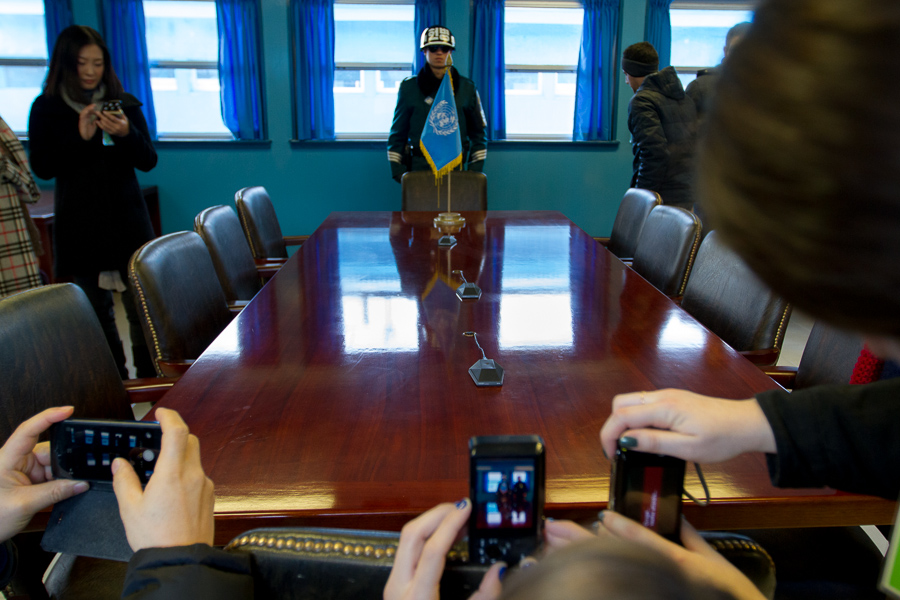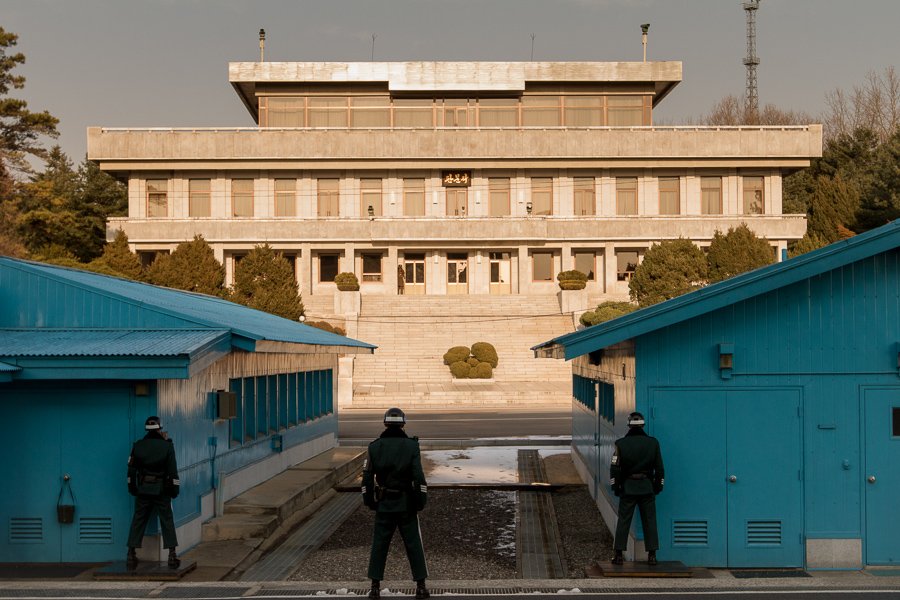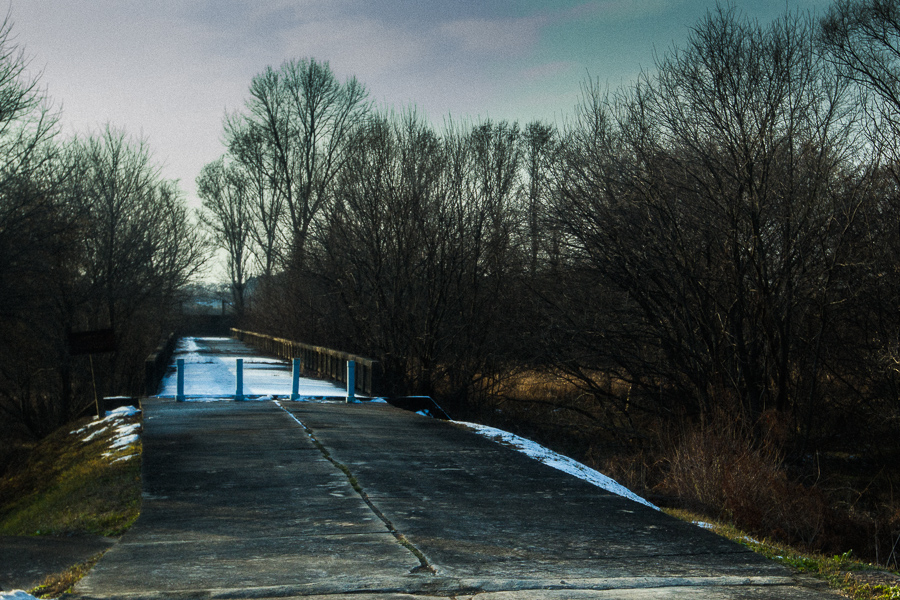Yesterday I spent four minutes in North Korea. Proof:

That's inside the Military Armistice Commission (MAC) conference building, within the Joint Security Area near the village of Panmunjom. The line of microphones on the desk follows the Military Demarcation Line (MDL) dividing North and South Korea. To my left is South Korea; to my right is North Korea.
You have to take an organized tour to get to the JSA. Because, let's review: (a) it's an active war zone; (b) it's a diplomatic base with heavy military presence; and (c) you don't want to get kidnapped by the DPRK. (The tour I took cost $78 and included a delicious bulgogi lunch at a roadhouse outside Puja.)
Here's the first up-close-and-personal view of North Korea you get:

The blue building to the left is the MAC Conference Center from the photo above. The blue building to the right is another ROK-administered structure. Running between them, on the ground, you can see a raised concrete curb about 10cm tall. That is the MDL—the border with North Korea. Assuming you could get past the armed U.S. Army guys I decided not to photograph, and get past the ROK officer in the center, and the two beefy MPs on either side, you could make that border in just a few steps from where I was standing. Then you'd have a really difficult time getting back over it, and a harder time, whether or not they let you back in South Korea, staying out of jail on one side or the other.
It's surreal. The border is an abstract concept but two enormous armies make connect the abstraction to reality. A bunch of tourists, half of them Japanese, took an ordinary tour bus to a United Nations military base a few hundred meters from a hostile country, got a slide show about axe murders and not gesturing to or speaking with North Koreans, then got on a U.N. bus and drove—slowly—past mine fields, tank defenses, and rice paddies. (About 700 people live just outside the JSA, within the DMZ.)
Here's another chilling place, the Bridge of No Return:

Yeah, don't cross that bridge. You won't come back. Seriously.
Today I'm heading over to the Korean History Museum and possibly the War Memorial. I've been thinking a lot about Seoul and my reactions to the city. At first approximation, modern Seoul is defined by a war that hasn't ended.
With only a few hours to go before I jet out of Chicago, I'm squeezing in client work and organizing my apartment while on conference calls. Also, I'm sending these to my Kindle:
Back to debugging...
Illinois' marriage equality act doesn't take effect for 7 months, but Federal District Judge Thomas Durkin (and I) believes the law's passage is enough to let a couple settle their affairs as they intended:
Vernita Gray and Patricia Ewert, will be issued their license early by the Cook County clerk’s office because one of the women is currently battling terminal cancer, their attorneys said.
County Clerk David Orr said he would comply with the order by U.S. District Judge Thomas M. Durkin
Orr said he also welcomed the ruling.
“As a supporter of same-sex marriage, I’m pleased Judge Durkin granted relief to Patricia Ewert and Vernita Gray in this difficult time,” he said in a statement.
This is the right result. The couple have a compelling reason to marry, and a delay would needlessly complicate their lives even though marriage will be generally available to all couples in just a few months. There's a little part of me that says the state marriage law should prevail here, but a bigger part of me that demands to know why the legislature put in an 8-month delay in the law's implementation. It's not like any of the county clerks has to remodel their offices to accommodate marriage equality; they just have to produce marriage licenses.
So, good on Judge Durkin. This is not the first time I've wanted to buy the man a drink. I expect it won't be the last.
Wow, this weekend was busier than I anticipated.
You know what's coming. Links!
Only a few more hours before I leave for the weekend. Time to jam on the billables...
Tomorrow afternoon is the Day of the Doctor already, and then in a little more than four days I'm off to faraway lands. Meanwhile, I'm watching a performance test that we'll repeat on Monday after we release a software upgrade.
So while riveted to this Live Meeting session, I am pointedly not reading these articles:
Perhaps more to the point, I'm not finishing up the release that will obviate the very performance test I'm watching right now. That is another story.
As interesting as infrastructure is to most people, it's possible this was a bigger story yesterday:
Gov. Pat Quinn on Wednesday put his signature on a historic measure making Illinois the 16th state to allow same-sex marriage, capping a 40-year push for gay rights that picked up major momentum during the past decade.
The bill-signing illustrated the rapidly changing views in Illinois and the nation on gay rights. Supporters first introduced an anti-discrimination bill in the legislature in 1974. It didn't became law until 2005. It took an additional six years for civil unions to be approved, but only about half that time for the gay marriage measure.
Still, support for same-sex marriage is far from universal in Illinois. As politicians talked up the merits of gay marriage in Chicago, down in Springfield, a crowd gathered for an exorcism by the local Catholic bishop in protest of the governor's action.
Excellent. Illinois becomes the 16th state to achieve marriage equality, and the best the opposition can do is hold a (literally) medieval ceremony down the street. Welcome to the 21st Century.
This brings the total number of people living in U.S. marriage-equality jurisdictions to 109.2 million, roughly 35% of the population.
After a year, the Wells Street bridge has reopened:
Just before 6:15 a.m., construction workers in reflective vests and hard hats dragged orange traffic barrels to the sidewalk, clearing the traffic lanes for the first time since last November.
Moments later, the first person crossed the bridge: Bike messenger Lionel Floyd. He pedaled south and appeared surprised to see a crowd of reporters waiting for him at Wacker Drive.
The $50 million reconstruction was aimed at extending the lifespan of the while maintaining its classic appearance. With the exception of two planned closures in this spring, CTA train service continued during the project.
Chicago infrastructure projects keep moving ahead. Last week Tribune transportation correspondent Jon Hilkevitch reported the Federal government may provide more funding for a $4 bn project to fix the north-side El:
That doesn't guarantee funding under the "new starts" grant program, but the transit administration allowed the CTA to apply because the Red-Purple Modernization project will add much-needed capacity and deliver more reliable service to the most heavily traveled CTA rail line, officials said.
The project will involve rebuilding the Red and Purple Line tracks, replacing stations and overhauling viaducts and the elevated embankment from north of Belmont through Evanston.
Various options and designs are under consideration and would cost between roughly $2 billion to more than $4 billion to engineer and construct, officials said.
The project is still in the planning phase.
A popular Canadian broadcaster, Rick Mercer, reminds Ontarians that Rob Ford's politics matter:
I had enough time during today's 8-hour meeting to queue up some articles to read later. Here they are:
As for today's meeting, this.
Another packed day, another link roundup:
All for now.